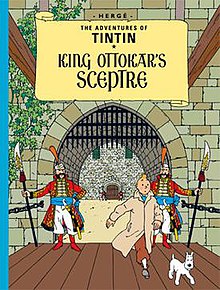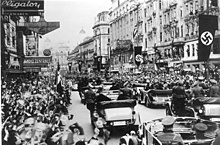King Ottokar's Sceptre
| King Ottokar's Sceptre (Le Sceptre d'Ottokar) | |
|---|---|
 Cover of the English edition | |
| Date |
|
| Series | The Adventures of Tintin |
| Publisher | Casterman |
| Creative team | |
| Creator | Hergé |
| Original publication | |
| Published in | Le Petit Vingtième |
| Date of publication | 4 August 1938 – 10 August 1939 |
| Language | French |
| Translation | |
| Publisher | Methuen |
| Date | 1958 |
| Translator |
|
| Chronology | |
| Preceded by | The Black Island (1938) |
| Followed by |
|
King Ottokar's Sceptre (French: Le Sceptre d'Ottokar) is the eighth volume of
King Ottokar's Sceptre was a commercial success and was published in book form by
Synopsis
Having discovered a lost briefcase in a Belgian park, Tintin returns it to its owner, the
Forcibly ejected from the plane by the pilot, Tintin survives and informs local police of his fears regarding the plot. However, the police captain is part of the conspiracy, and he organises an ambush in the woods where Tintin will be eliminated. Tintin evades death, and heads to the capital city of Klow in a car carrying the opera singer
With the aid of Thomson and Thompson, who have recently arrived in Syldavia, Tintin discovers how the conspirators smuggled out the sceptre from the Castle and pursues the thieves, first by car and then by foot across the mountains. He is able to prevent the sceptre being carried over the border into neighbouring Borduria, discovering a letter on one of the conspirators. It reveals that the plot has been orchestrated by
History
Background

King Ottokar's Sceptre was not the first Tintin adventure to draw specifically on contemporary events;
Hergé claimed that the basic idea behind the story had been given to him by a friend; biographer Benoît Peeters suggested that the most likely candidate was school and scouting friend Philippe Gérard, who had warned of a second war with Germany for years.[15] Tintin scholars have claimed Hergé did not develop the names Syldavia and Borduria himself;[a] instead, the country names had supposedly appeared in a paper included in a 1937 edition of the British Journal of Psychology, in which the author described a hypothetical conflict between a small kingdom and an annexing power.[17] Reportedly, the paper, by Lewis Fry Richardson and entitled "General Foreign Policy", explored the nature of inter-state conflict in a mathematical way.[17] Peeters attributed these claims to Georges Laurenceau, but said that "no researcher has confirmed this source". Instead, a paper by Richardson entitled "Generalized Foreign Politics: A Story in Group Psychology" was published in The British Journal of Psychology Monograph Supplements in 1939, but did not mention Syldavia or Borduria. In any case, given the publication date, it is unlikely that it was an influence on King Ottokar's Sceptre.[18]
"At the time, Germany was of course on my mind; Ottokar's Sceptre is nothing other than the tale of a failed Anschluss. But one can take it to be any other totalitarian regime ... Moreover, isn't the villain of Ottokar's Sceptre called
Müsstler, evidently a combination of Mussolini and Hitler? It strikes me as a clear allusion".
Hergé, talking to Numa Sadoul[19]
Hergé designed Borduria as a satirical depiction of Nazi Germany.[20] Hergé named the pro-Bordurian agitator "Müsstler" from the surnames of Nazi leader Adolf Hitler and Italy's National Fascist leader Benito Mussolini.[21] The name also had similarities with the British Union of Fascists' leader Oswald Mosley and the National Socialist Movement in the Netherlands' leader Anton Mussert.[22] Müsstler's group was named after the Iron Guard, a Romanian fascist group that sought to oust King Carol II and forge a Romanian-German alliance.[23] The Bordurian officers wore uniforms based on those of the German SS,[20] while the Bordurian planes are German in design; in the original version Tintin escapes in a Heinkel He 112,[24] while in the revised version this is replaced by a Messerschmitt Bf 109.[25] Hergé adopted the basis of Borduria's false flag operation to take over Syldavia from the plans outlined in Curzio Malaparte's Coup d'État: The Technique of Revolution.[26]
Syldavia's depiction was influenced by the costumes and cultures of

The name Syldavia may be a composite of
However, despite its Eastern European location, Syldavia itself was partly a metaphor for Belgium – Syldavian King Muskar XII physically resembles King
Original publication
King Ottokar's Sceptre was first serialised in Le Petit Vingtième from 4 August 1938 to 10 August 1939 under the title Tintin En Syldavie ("Tintin in Syldavia").[39] It would prove to be the last Tintin adventure to be published in its entirety in Le Petit Vingtième.[40] From 14 May 1939, the story was also serialised in the French Catholic newspaper, Cœurs Vaillants.[40] In 1939, Éditions Casterman collected the story together in a single hardcover volume; Hergé insisted to his contact at Casterman, Charles Lesne, that they hurry up the process due to the changing political situation in Europe.[41] The Nazi–Soviet Molotov–Ribbentrop Pact was signed the day Hergé delivered the book's remaining drawings;[42] finishing touches included the book's original front cover, the royal coat of arms for the title page, and the tapestry depicting the Syldavian's 1127 victory over the Turks in "The Battle of Zileheroum" on page 20.[43] Hergé suggested that for this publication, the story's title be changed to The Scepter of Ottokar IV; Casterman changed this to King Ottokar's Sceptre.[44]
King Ottokar's Sceptre introduced the recurring character of Bianca Castafiore to the series, who appears alongside her pianist
After the conclusion of King Ottokar's Sceptre, Hergé continued The Adventures of Tintin with Land of Black Gold until Germany placed Belgium under occupation in 1940 and forced the closure of Le Vingtième Siècle. The adventure Land of Black Gold had to be abandoned.[48][c]
Second version, 1947
The story was redrawn and colourised in 1947. For this edition, Hergé was assisted by
Subsequent publications and legacy
King Ottokar's Sceptre became the first Tintin adventure to be published for a British audience when
Casterman republished the original black-and-white version of the story in 1980, as part of the fourth volume in their Archives Hergé collection.[40] In 1988, they then published a facsimile version of that first edition.[40]
Critical analysis

Jean-Marc Lofficier and Randy Lofficier called King Ottokar's Sceptre "a Hitchcockian thriller" which "recaptures the paranoid ambience" of Cigars of the Pharaoh.[57] They compared the pace of the latter part of the story to that of Steven Spielberg's Indiana Jones films before noting that despite the "horrors of the real world" that are present with Borduria's inclusion, they do not interfere in "the pure escapist nature of the adventure". Ultimately they awarded it three stars out of five.[57]
Literary critic Jean-Marie Apostolidès of Stanford University asserted that the inclusion of the Iron Guard evoked Colonel François de La Rocque's Croix-de-Feu.[60] Noting that the figure of Müsstler was "the Evil One without a face", he expressed disbelief regarding Hergé's depiction of Syldavia, as there were no apparent economic problems or reasons why Müsstler's anti-monarchist conspiracy was so strong; thus, "mass revolution remains schematic".[60]
Literary critic
Adaptations
King Ottokar's Sceptre was the first of The Adventures of Tintin to be adapted for the animated series
Tintin fans adopted the Syldavian language that appears in the story and used it to construct grammars and dictionaries, akin to the fan following of
References
Notes
Footnotes
- ^ Hergé 1958, pp. 1–7.
- ^ Hergé 1958, pp. 7–15.
- ^ Hergé 1958, pp. 15–22.
- ^ Hergé 1958, pp. 23–28.
- ^ Hergé 1958, pp. 29–38.
- ^ Hergé 1958, pp. 38–46.
- ^ Hergé 1958, pp. 47–53.
- ^ Hergé 1958, pp. 54–60.
- ^ Assouline 2009, p. 61.
- ^ a b Peeters 2012, p. 97.
- ^ Thompson 1991, p. 82; Farr 2001, p. 81; Assouline 2009, p. 61; Peeters 2012, p. 97; Goddin 2009, pp. 40.
- ^ Farr 2001, p. 81; Peeters 2012, p. 97; Goddin 2009, pp. 40, 49.
- ^ Farr 2001, p. 81; Assouline 2009, p. 62; Goddin 2009, p. 50.
- ^ a b c d e Assouline 2009, p. 62.
- ^ Peeters 2012, p. 98; Goddin 2009, p. 40.
- ^ Goddin 2009.
- ^ a b Farr 2001, p. 82; Libération 2006.
- ^ Peeters 2012, p. 325.
- ^ Sadoul 1975; Farr 2001, p. 82.
- ^ a b Thompson 1991, p. 83; Apostolidès 2010, p. 29.
- ^ Thompson 1991, p. 82; Lofficier & Lofficier 2002, p. 43; Assouline 2009, p. 62; Peeters 2012, p. 98.
- ^ Peeters 2012, p. 98.
- ^ Thompson 1991, p. 82; Farr 2001, p. 81.
- ^ a b Goddin 2009, p. 50.
- ^ Farr 2001, pp. 84–85; Apostolidès 2010, p. 29.
- ^ a b c Peeters 2012, p. 99.
- ^ Peeters 2012, p. 100; Goddin 2009, p. 50.
- ^ a b Thompson 1991, p. 83; Farr 2001, p. 81.
- ^ Tett 2012, p. 8.
- ^ a b c d Tett 2012, p. 9.
- ^ a b Farr 2001, p. 81.
- ^ Farr 2001, p. 82; Peeters 2012, p. 100.
- ^ Lofficier & Lofficier 2002, p. 43.
- ^ Farr 2001, p. 82.
- ^ Tett 2012, p. 12-13.
- ^ Tett 2012, p. 11.
- ^ Tett 2012, p. 23.
- ^ Tett 2012, p. 18-19.
- ^ Peeters 1989, p. 62; Lofficier & Lofficier 2002, p. 42; Goddin 2009, p. 37.
- ^ a b c d e Lofficier & Lofficier 2002, p. 42.
- ^ Lofficier & Lofficier 2002, p. 42; Assouline 2009, p. 62; Peeters 2012, pp. 100–101; Goddin 2009, p. 53.
- ^ Goddin 2009, p. 57.
- ^ Goddin 2009, pp. 53, 56–57.
- ^ Assouline 2009, p. 63.
- ^ Thompson 1991, p. 84; Lofficier & Lofficier 2002, p. 43; Peeters 2012, p. 100; Goddin 2009, p. 43.
- ^ a b Thompson 1991, p. 84.
- ^ Peeters 2012, p. 100.
- ^ Assouline 2009, pp. 68–69; Goddin 2009, p. 70; Peeters 2012, p. 114.
- ^ Thompson 1991, p. 84; Farr 2001, p. 87; Lofficier & Lofficier 2002, p. 44.
- ^ Farr 2001, p. 87; Lofficier & Lofficier 2002, p. 44.
- ^ Tett 2012, p. 22.
- ^ Farr 2001, pp. 87, 89.
- ^ Thompson 1991, p. 86.
- ^ Thompson 1991, p. 82.
- ^ a b Thompson 1991, p. 83.
- ^ Thompson 1991, pp. 83–84.
- ^ a b Lofficier & Lofficier 2002, p. 44.
- ^ a b Farr 2001, p. 85.
- ^ Farr 2001, p. 89.
- ^ a b Apostolidès 2010, p. 29.
- ^ McCarthy 2006, p. 70.
- ^ McCarthy 2006, p. 122.
- ^ McCarthy 2006, p. 53.
- ^ McCarthy 2006, p. 100.
- ^ Lofficier & Lofficier 2002, p. 87.
- ^ a b Lofficier & Lofficier 2002, p. 90.
- ^ Lofficier & Lofficier 2002, p. 43; Rogers 2011, p. 215; Rosenfelder 1996.
Bibliography
- ISBN 978-0-8047-6031-7.
- ISBN 978-0-19-539759-8.
- ISBN 978-0-7195-5522-0.
- ISBN 978-0-86719-724-2.
- ]
- Lindon, Mathieu (21 August 2006). "Une métaphore de la Belgique" [A metaphor of Belgium]. Libération (in French). Paris. Retrieved 18 June 2014.
- ISBN 978-1-904048-17-6.
- ISBN 978-1-86207-831-4.
- ISBN 978-0-416-14882-4.
- ISBN 978-1-4214-0454-7.
- Rogers, Stephen D. (2011). The Dictionary of Made-Up Languages: From Elvish to Klingon. New York City: Adams Media, a division of ISBN 978-1-4405-3039-5.
- Rosenfelder, Mark (1996). "Hergé's Syldavian: A grammar". Archived from the original on 9 February 2014. Retrieved 18 June 2014.
- ISBN 978-2-08-080052-7.
- Tett, Stuart (10 January 2012). King Ottokar's Sceptre: The Real-life Inspiration Behind Tintin's Adventures. New York City: Little, Brown and Company. ISBN 978-0-316-13383-8.
- ISBN 978-0-340-52393-3.
External links
- King Ottokar's Sceptre at the Official Tintin Website
- King Ottokar's Sceptre at Tintinologist.org
